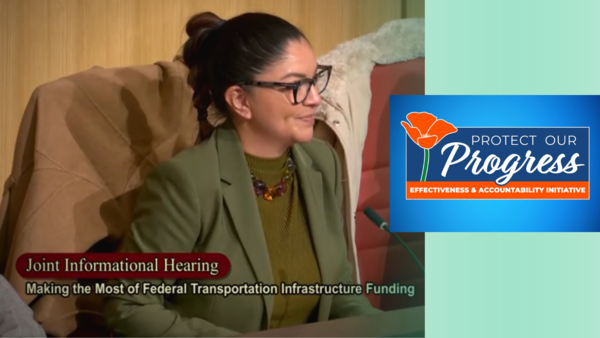March 15, 2023

- March 14th Joint Transportation and Senate Budget Subcommittee #5 Hearing: In the face of a predicted budget deficit for this fiscal year, the Senate remains committed to reinforcing and maintaining commitments to vital programs, projects, and services for all Californians. That is why I convened an oversight hearing to talk about how we can make the most of the $1.2 trillion Infrastructure Investment and Jobs Act to create more jobs and fund critical transportation infrastructure projects to protect our progress from previous budget years. You can watch the full hearing here.
- March 21st SB 507 The Equitable EVs Charging Act Passes Senate Committee on Energy, Utilities & Communications: To date, analyses by the California Energy Commission and other state agencies have been critical to understanding statewide EV charging needs. However, theses analyses do not quantify infrastructure needs for underserved communities, which is crucial to identify how the State can direct investments that will increase equitable access to EV chargers. That is why I have introduced SB 507 The Equitable EVs Charging Act, which will require the CEC to quantify EV infrastructure needs for underserved groups throughout the state. This data will also provide policymakers and researchers a better understanding of whether policy gaps contribute to inequitable investment, and whether charging technology or product offerings are meeting the unique needs of communities. I am happy to report that the bill successfully passed its first policy committee hearing, listen to my remarks, testimony from supporters, and member discussions on the bill during the hearing here.
- March 28th Transportation Hearing: Tune in to this hearing as we review the California High-Speed Rail Authority’s recently released 2023 Project Update Report. Last year, the Legislature took a number of steps to increase oversight of the HSR project, including requiring the Authority to fulfill federal commitments and to focus on delivering a usable rail segment from Merced to Bakersfield. Additionally, we created a new, independent Office of the Inspector General to not only oversee operations at the Authority, but to also provide an independent analysis of the Authority’s plans and financial estimates. For the hearing agenda and public comment information visit the Senate Transportation Committee webpage.
- During the hearing, I will present my bill SB 695 the California State Highway Transparency Act. This bill will make information about past and future highway expansion projects more accessible to the public. Specifically, the bill will require the California Department of Transportation (Caltrans) to report this data every year. The data must include descriptions of lane miles added to the state highway system, what purpose the miles serve, and features included in the project, such as complete streets and transit. I believe greater transparency about the history and future changes to our highways is important in protecting disproportionately impacted communities of color who are often the most impacted by highway expansions that separate neighborhoods and increase exposure to air pollution from cars and trucks, roadway noise, and safety concerns. As our highways become more congested, research has shown that we cannot simply build our way out of the problem. Adding capacity through new lanes or interchanges often induces more people to drive which contributes to increased emissions and climate impacts. Learn more about SB 695 here.
- SB 394 The Master Plan for Sustainable and Climate-Resilient Schools: I am happy to announce that the bill’s full language is ready for you to access online! This bill will require the California Energy Commission (CEC) to develop a Master Plan for Healthy, Sustainable, and Climate-Resilient Schools (Master Plan). California is home to over 1,000 school districts that utilize more than 10,000 school facilities, comprising 125,000 acres of grounds, and 730 million square feet of facilities that produce substantial GHG emissions and contribute to other environmental impacts. It’s time to align the $7 billion California spends annually to build and modernize school facilities with the State’s climate goals. LA Times reporter Sammy Roth said it best, “we can’t solve the climate crisis without schools — and teachers”. Want to learn more? Check out our SB 394 Fact Sheet here, the bill language here and a recent report on the need for climate resilient California schools here.
- SB 84 The Clean Transportation Program: This year I have introduced Senate Bill 84 to revitalize and extend California’s existing Clean Transportation Program (CTP) by prioritizing equity and aligning the program with California’s current environmental and emissions targets. Learn more about the CTP and how SB 84 can help advance technologies and markets necessary to decarbonize the transportation sector here.
- Broadband Updates: In 2021, the Legislature passed a historic package of broadband legislation, including two bills I championed SB 4 and SB 156. SB 156 established a framework for constructing state-owned middle mile broadband infrastructure overseen by the California Department of Technology (CDT) and allocated $2 billion to the California Public Utilities Commission (CPUC) for last mile broadband funding opportunities. Since the passage of this legislation, the CPUC and CDT have taken several steps towards implementing SB 156 and related legislation to expand broadband access. However, a substantial amount of broadband infrastructure funding remains unspent. This oversight hearing examined the state’s progress towards implementing the 2021 broadband investments, explored challenges to connecting unserved Californians, as well as opportunities for ongoing state broadband investments to equitably address connectivity challenges. You can read the full broadband investments background report here. And watch the oversight hearing here, State Broadband Investments: Progress Towards Connecting the Unserved.
